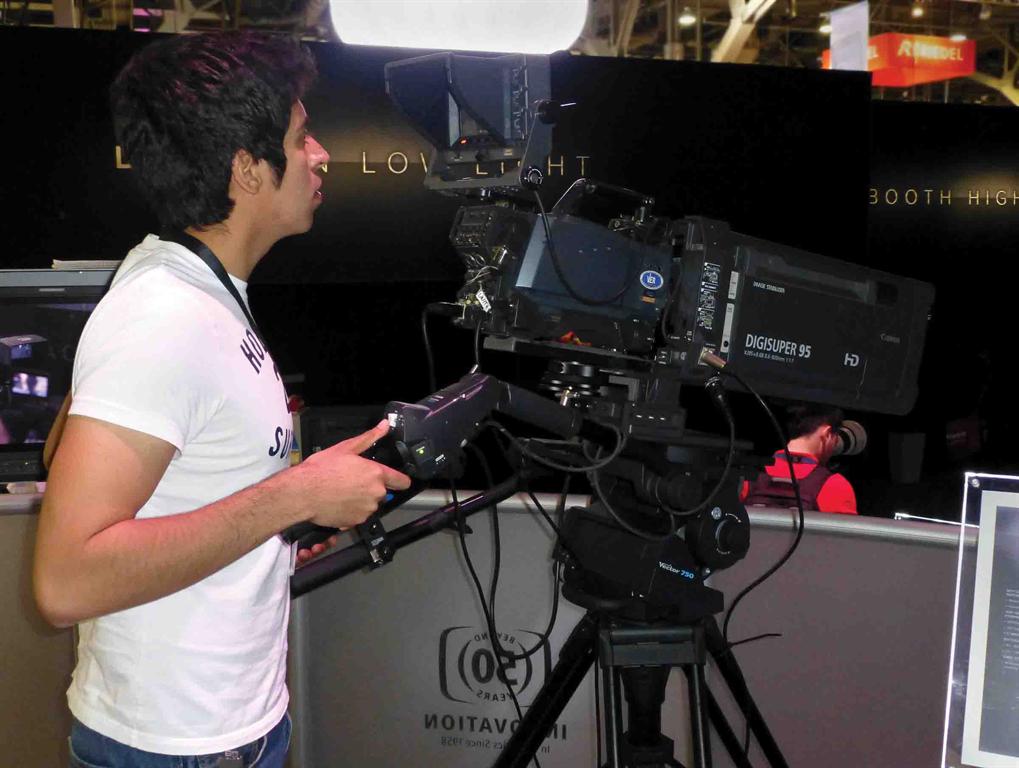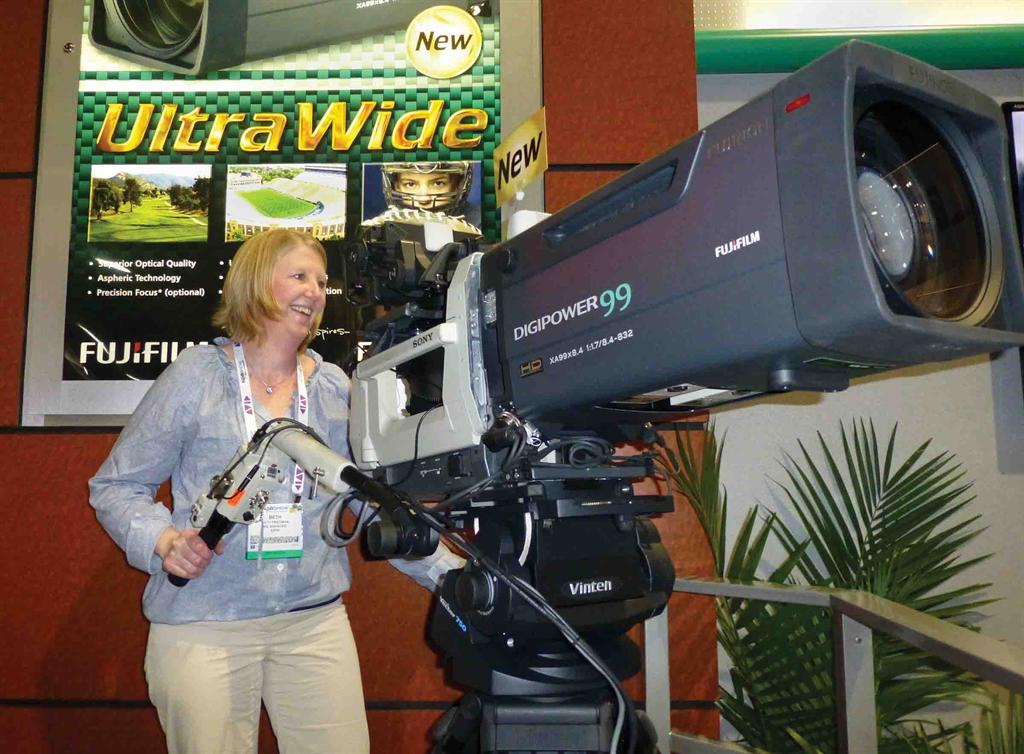2013 NAB Product Review: Lenses

Jean Le Poulain (R) of Angenieux discusses the Optimo 56-152 PL-mount anamorphic lens on an Arri Alexa camera with Bjorn Thisell of Ljud & Bildmedia in Sweden. The high-end lens market saw some notable introductions at the 2013 NAB Show, designed to deliver 4K and better-resolution images to the large-format sensor 4K cameras. New anamorphic lenses were also in evidence.
Angenieux unveiled its lightweight Optimo Anamorphic 56-152mm 2S (2x squeeze) Zoom Lens designed to lend film-like dimensional character to images. Angenieux touts the low distortion and fast T4 aperture of the lens, with ramping or breathing. The anamorphic Optimo zoom features all of the characteristics shared by the company’s Optimo lens series, including pristine optics, high-precision mechanical zoom system and 320-degrees focus rotation with more than 50 focus marks.
Band Pro showcased its Leica Summilux-C lenses, PL-mount primes designed to deliver ultra-high optical performance for film and digital capture. The T1.4 close focus primes employ a unique multi-aspheric design and high-precision cine lens mechanics to provide flat field illumination across the entire 35mm frame, and suppression of color fringing in the farthest corners of the frame with no discernible breathing.

Rafael Gonzalez of the University Del Valle de Mexico takes a closer look at the Canon XJ95x8.6B Digisuper lens.Canon is filling the need for a large-format, single-sensor prime lens between its previously introduced 24mm and 50mm by announcing development of a 35mm lens to the series. Canon’s Cinema prime lenses are part of the Canon Cinema EOS System of professional digital cinematography products. The new lens is expected to be available later this year. Canon also showed the DIGISUPER 95 (XJ95x8.6B). The super-telefoto lens that capitalizes on Canon’s XJ95x, combining the focal length (8.6mm) with a 95x zoom range that’s longer at the tele end.
Carl Zeiss presented its Master Anamorphic lenses, jointly developed with ARRI. The lenses incorporate new optical anamorphic lens technology, with optimized flare control, virtually no image breathing and a newly developed iris with 15 aperture blades. Also new from Zeiss are 28-80 and 70-200mm compact zoom lenses, providing 4K performance and full-frame coverage with an interchangeable mount system providing PL, EF, F, MFT and E lens mounts.
Fujinon introduced its Premier PL 14-28mm Cabrio wide-angle lens, designed for close-up, ENG or Cine style shooting. It features a focal length of 14-28mm at T2.9 with 200-degree focus rotation. It was designed using the latest optical simulation technology to provide high-quality optical performance from the center of the image out to the corners of the frame. Its digital servo’s 16-bit encoding assures operators that all lens data output, such as position of the zoom, iris and focus, is extremely accurate.

Beth Friedman of ESPN takes a look at the Fujinon XA99x8.4 ultra-wide lens. Also showing was the XA55x9.5 HDTV Telephoto Box Style lens, designed for large venues that require tight shots from long distances. The lens features optical image stabilization.
Nikon unveiled its AF-S NIKKOR 80-400mm f/4.5-5.6G ED VR Telephoto Lens, featuring a minimum focus as close as 5.7 feet at all focal lengths. The lens internal focus mechanism allows for a compact body. The front lens elements do not rotate when focusing, and its Silent Wave Motor (SWM) technology provides not only fast autofocus, but smooth and quiet operation.
Schneider Optics unveiled its iPro iPhone5 case and Series 2 lenses. The many changes in the iPhone 5 required a completely new iPro case for mounting iPro lenses. The new iPhone 5 case is a two-piece system for easier installation and removal of the slim profile and soft touch feel case. Joining the fisheye, the 0.6x wide-angle and the 2x telephoto are a super-wide 0.45x and a macro lens. The original fisheye and wide-angle have been redesigned.
FILTERS
Schneider Optics presented its True-Streak Filter series, designed to provide dramatic horizontal streak effects generated by point-sources of light shined into the lens. The True-Streaks are made from the same water white optical glass as Schneider’s other filters, and come in a variety of colors including red, orange, green, yellow, violet, blue and pink, as well as clear. Each color filter is available in four steps of strength to provide a high degree of control of the effect.
Tiffen debuted an array of new filters that combine infrared neutral density (IRND) filtering with other popular Tiffen filter properties into single glass filters. IRND filtering has become critical for preventing unwanted Infrared light from reaching the CMOS sensors in digital cinematography cameras.
DPs who wanted as few reflective surfaces in the matte box as possible asked Tiffen to make some combination IRND filters. The first such combination filter was Tiffen’s IRND + polarizer, followed by IRND filters with various steps of diffusion. The line is growing.
The professional video industry's #1 source for news, trends and product and tech information. Sign up below.
